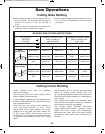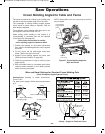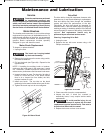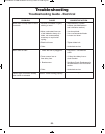
*
52; :.86;4 . 0<:=<B;1 0BA
<; . :<916;4 9F6;4 39.A <; A52
A./92;.??<D 0BA<33=6202@ <? 92@@6; D61A5
:.F /2 =?<=29921 .A 5645 @=221 <C2? A52 32;02
.;1/2F<;1A52/.08<3A52A<<9@2264B?2
(
@2 .BE696.?F 32;02 .@ 6;@A?B0A21 .;1 @5<D; 6;
364B?2@/29<D
64B?2BA<33$6202#C2?2;02
An auxiliary fence is used to add support to the cut-
off workpiece such as large crown molding when cut
flat on the table (see Figure 60). It will reduce
splintering and movement of the unsupported cut-off
piece of wood after the cut is made.
64B?2BA<33$6202&A<==21/F
BE696.?F2;02
!.86;4.;BE696.?F2;02
Required pieces:
W
ood Board (described below)
4 – Flat Head Machine Screws – 1/4" diameter;
2-1/2" long
4 – 1/4" Flat Washers
4 – Nuts
1. Cut a nominal 1" x 2" wood board to a length of 26-
1/16" long. NOTE: 1 x 2" nominal equals
3/4" x 1-1/2" actual. 3/4" plywood cut to size may
be substituted.
2. Drill four holes through the board using a 5/16"
diameter drill bit. Countersink the holes deep
enough so that the flat head screws will rest below
the front work surface – use a 1/2" diameter drill bit
(see Figure 61).
Remove the sliding fences from the tool – see page 29.
1. Place the flat head screws through the holes in the
auxiliary fence, then the holes in the stationary
fence on the tool.
2. Place the washers and nuts over the screw
threads and against the stationary fence. Tighten
nuts.
6?@A'6:2(@2<3A52BE696.?F2;02
NOTE: The first time the auxiliary fence is used, it will
be cut through by the saw blade – cutting through
creates minimal clearance which reduces splintering
on the workpiece. Set the miter angle and the bevel
angle required before making the first cut. Clamp the
workpiece, then make cut – example: compound
cutting large crown molding flat on the table (see
Figure 58).
*%""
!
Small Cut-off Piece Stationary Fence
Auxiliary FenceSmall Cut-off Piece
Saw Operations
?<D;!<916;4BE696.?F2;02
BM 2610007877 04-10:BM 2610007877 04-10.qxp 4/26/10 8:13 AM Page 48


















